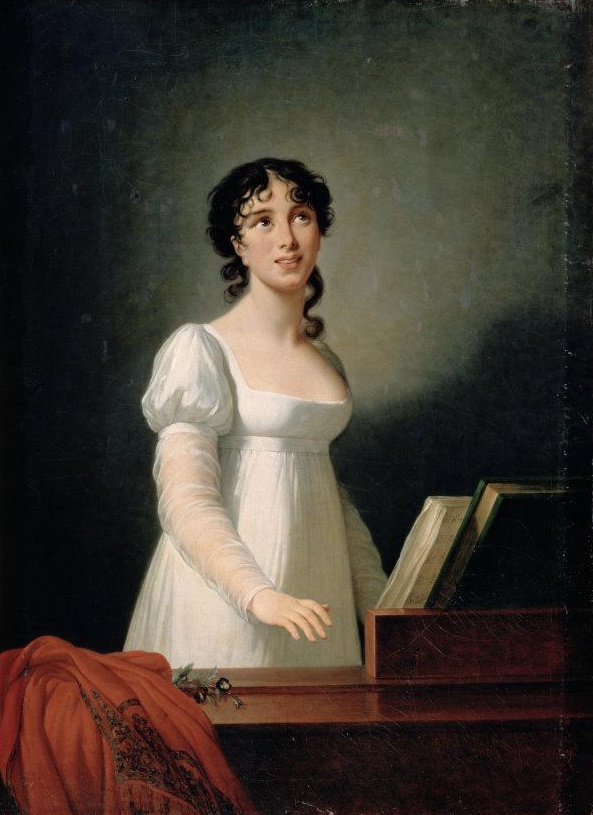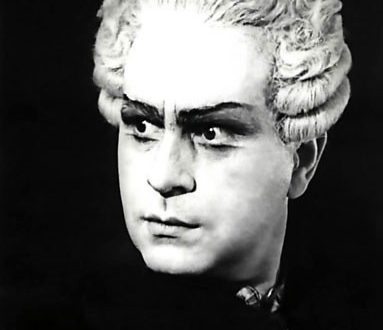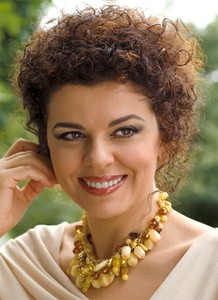
Angelica Catalani (Angelica Catalani) |
Angelica Catalan
Catalani is truly a remarkable phenomenon in the world of vocal art. Paolo Scyudo called the coloratura singer “a wonder of nature” for her exceptional technical skill. Angelica Catalani was born on May 10, 1780 in the Italian town of Gubbio, in the region of Umbria. Her father Antonio Catalani, an enterprising man, was known both as a county judge and as the first bass of the chapel of Senigallo Cathedral.
Already in early childhood, Angelica had a beautiful voice. Her father entrusted her education to the conductor Pietro Morandi. Then, trying to alleviate the plight of the family, he assigned a twelve-year-old girl to the monastery of Santa Lucia. For two years, many parishioners came here just to hear her sing.
Shortly after returning home, the girl went to Florence to study with the famous sopranist Luigi Marchesi. Marchesi, an adherent of an outwardly spectacular vocal style, found it necessary to share with his student mainly his amazing art in singing various kinds of vocal embellishments, technical mastery. Angelica turned out to be a capable student, and soon a gifted and virtuoso singer was born.
In 1797, Catalani made his debut at the Venetian theater “La Fenice” in S. Mayr’s opera “Lodoiska”. Theater visitors immediately noted the high, sonorous voice of the new artist. And given the rare beauty and charm of Angelica, her success is understandable. The following year she performs in Livorno, a year later she sings at the Pergola Theater in Florence, and spends the last year of the century in Trieste.
The new century begins very successfully – on January 21, 1801, Catalani sings for the first time on the stage of the famous La Scala. “Wherever the young singer appeared, everywhere the audience paid tribute to her art,” writes V.V. Timokhin. – True, the artist’s singing was not marked by a depth of feeling, she did not stand out for the immediacy of her stage behavior, but in lively, upbeat, bravura music she knew no equal. The exceptional beauty of Catalani’s voice, which once touched the hearts of ordinary parishioners, now, combined with remarkable technique, delighted lovers of opera singing.
In 1804, the singer leaves for Lisbon. In the capital of Portugal, she becomes a soloist of the local Italian opera. Catalani is quickly becoming a favorite with local listeners.
In 1806, Angelica enters into a lucrative contract with the London Opera. On the way to “foggy Albion” she gives several concerts in Madrid, and then sings in Paris for several months.
In the hall of the “National Academy of Music” from June to September, Catalani demonstrated her art in three concert programs, and each time there was a full house. It was said that only the appearance of the great Paganini could produce the same effect. Critics were struck by the vast range, the amazing lightness of the singer’s voice.
The art of Catalani also conquered Napoleon. The Italian actress was summoned to the Tuileries, where she had a conversation with the emperor. “Where are you going?” the commander asked his interlocutor. “To London, my lord,” said Catalani. “It is better to stay in Paris, here you will be well paid and your talent will be truly appreciated. You will receive one hundred thousand francs a year and two months’ leave. It’s decided; goodbye madam.”
However, Catalani remained faithful to the agreement with the London theater. She fled from France on a steamship designed to transport prisoners. In December 1806, Catalani sang for the first time for Londoners in the Portuguese opera Semiramide.
After the closing of the theatrical season in the capital of England, the singer, as a rule, undertook concert tours in the English provinces. “Her name, announced on posters, attracted crowds of people to the smallest cities in the country,” eyewitnesses point out.
After the fall of Napoleon in 1814, Catalani returned to France, and then went on a large and successful tour of Germany, Denmark, Sweden, Belgium and Holland.
The most popular among the listeners were such works as “Semiramide” by Portugal, variations of Rode, arias from the operas “The Beautiful Miller’s Woman” by Giovanni Paisiello, “Three Sultans” by Vincenzo Puccita (accompanist of Catalani). European audiences favorably accepted her performances in the works of Cimarosa, Nicolini, Picchini and Rossini.
After returning to Paris, Catalani becomes director of the Italian Opera. However, her husband, Paul Valabregue, actually managed the theater. He tried in the first place to ensure the profitability of the enterprise. Hence the reduction in the cost of staging performances, as well as the maximum reduction in costs for such “minor” attributes of an opera performance, such as the choir and orchestra.
In May 1816, Catalani returns to the stage. Her performances in Munich, Venice and Naples follow. Only in August 1817, having returned to Paris, she for a short time again became the head of the Italian Opera. But less than a year later, in April 1818, Catalani finally left his post. For the next decade, she constantly toured Europe. By that time, Catalani rarely took the once magnificent high notes, but the former flexibility and power of her voice still captivated the audience.
In 1823 Catalani visited the Russian capital for the first time. In St. Petersburg, she was given the most cordial welcome. On January 6, 1825, Catalani participated in the opening of the modern building of the Bolshoi Theater in Moscow. She performed the part of Erato in the prologue of the “Celebration of the Muses”, the music of which was written by Russian composers A.N. Verstovsky and A.A. Alyabiev.
In 1826, Catalani toured Italy, performing in Genoa, Naples and Rome. In 1827 she visited Germany. And the next season, in the year of the thirtieth anniversary of artistic activity, Catalani decided to leave the stage. The last performance of the singer took place in 1828 in Dublin.
Later, in her home in Florence, the artist taught singing to young girls who were preparing for a theatrical career. She sang now only for acquaintances and friends. They could not help but praise, and even at a venerable age, the singer did not lose many of the precious properties of her voice. Fleeing from the cholera epidemic that broke out in Italy, Catalani rushed to the children in Paris. However, ironically, she died from this disease on June 12, 1849.
V.V. Timokhin writes:
“Angelica Catalani rightfully belongs to those major artists who have been the pride of the Italian vocal school over the past two centuries. The rarest talent, excellent memory, the ability to incredibly quickly master the laws of singing mastery determined the singer’s enormous success on opera stages and in concert halls in the vast majority of European countries.
Natural beauty, strength, lightness, extraordinary mobility of the voice, the range of which extended up to the “salt” of the third octave, gave grounds to speak of the singer as the owner of one of the most perfect vocal apparatus. Catalani was an unsurpassed virtuoso and it was this side of her art that won universal fame. She lavished all kinds of vocal embellishments with unusual generosity. She brilliantly managed, like her younger contemporary, the famous tenor Rubini and other outstanding Italian singers of that time, the contrasts between the energetic forte and the captivating, gentle mezza voce. The listeners were especially struck by the phenomenal freedom, purity and speed with which the artist sang chromatic scales, up and down, making a trill at every semitone.





